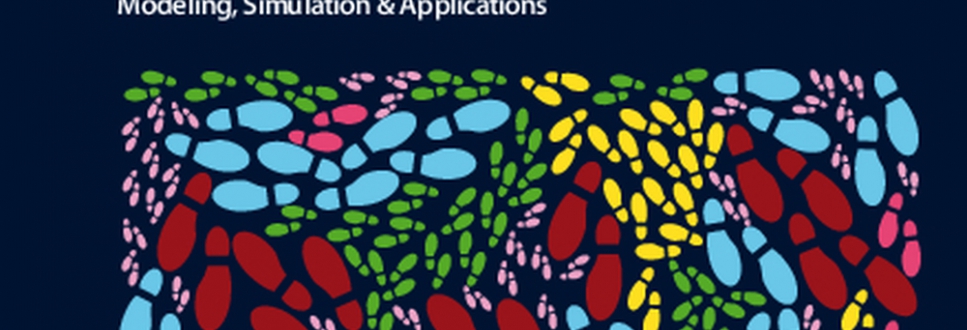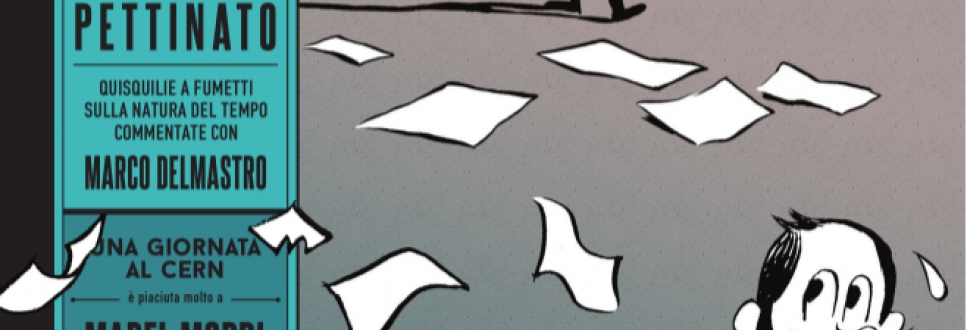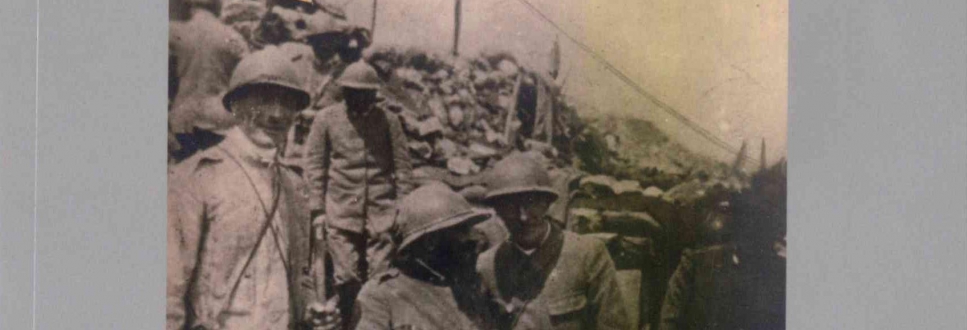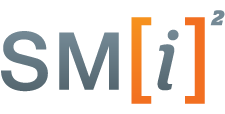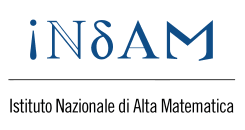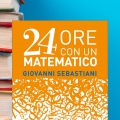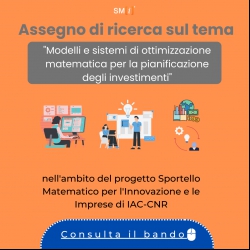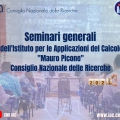
Seminari generali IAC 2021
2021-02-18
Ciclo di seminari IAC sulle attività di ricerca in matematica applicata.
Dal mese di febbraio 2021 i ricercatori che hanno recentemente preso servizio presso l'IAC stanno dando vita a un ciclo di seminari generali dedicati alle ricerche di matematica applicata nelle varie aree tematiche presenti in istituto.
Tutti i seminari sono trasmessi in streaming sul canale Youtube dell'istituto @CNRIAC.
I seminari si tengono sempre alle ore 14:30.
Di seguito il calendario dei seminari in programma (dal più recente).
Title: Multi-Word Structural Topic Modelling of Tor Drug Marketplaces
Abstract: Topic Modelling (TM) is a widely adopted generative model used toinfer the thematic organization of text corpora. When document-level covariate information is available, so-called Structural Topic Modelling (STM) is the state-of-the-art approach to embed this information in the topic mining algorithm. Usually, TM algorithms rely on unigrams as the basic text generation unit, whereas the quality and intelligibility of the identified topics would significantly benefit from the detection and usage of topical phrasemes. Following on from previous research, in this paper we propose the first iterative algorithm to extend STM with n-grams, and we test our solution on textual data collected from four well-known ToR drug marketplaces. Significantly, we employ a STM-guided n-gram selection process, so that topic-specific phrasemes can be identified regardless of their global relevance in the corpus. Our experiments show that enriching the dictionary with selected n-grams improves the usability of STM, allowing the discovery of key information hidden in an apparently “mono-thematic” dataset.
01/12/2021 – Simone Melchionna
Title: AI-driven biomechanism to quantify the impact of Covid disease on breathing
Abstract: The Covid disease causes pneumonia in many patients that in the most serious cases evolves into the Acute Distress Respiratory Syndrome (ARDS), requiring assisted ventilation and intensive care. In this context, the identification of patients at high risk of developing ARDS is a key point for early clinical management, better clinical outcomes, and optimization of resources available in intensive care units. We are currently developing an AI-based computational framework that aims at predicting the ventilation efficiency of patients by using as input lung Computed Tomography (CT), the air flux in lungs obtained from biomechanical simulations, and Arterial Blood Gas analysis. By using a dual approach from AI and computer simulations we investigated the feasibility of the approach on a small clinical database of proven Covid cases where the initial CT and various reports were available. We studied the time evolution of the clinical parameters and found a correlation between the morphological information extracted from CT scans and disease outcome. Promising results illustrate the ability to predict the evolution of respiratory efficiency an aspect that would be of crucial importance for disease management.
10/06/2021 – Donatella Granata
Title: Interdiction Networks and Critical Disruption Path problem
Abstract: Many real-life optimization problems can accurately be represented as networks, this talk will be structured in two main parts. In the first one, we will introduce how it is important from interdiction perspectives to predict and evaluate the behavior of the system, via measuring the rules governing individual vertices, edges, or associated substructures, whose malfunctioning prevents the functionality of the network as a whole. In the second part, we will deal with the Critical Disruption Path problem presenting some variants and exact and meta-heuristics procedures to face it.
3/6/2020 - Maria Concetta Palumbo
Title: When modeling and estimation collide, I can get no satisfaction
Abstract: In this talk, I will present a problem regarding introducing a model of the effects of physical exercise in body metabolism in one of the most important models for glucose homeostasis. The procedure of parameter estimation, in this case, seems to collide with the experimental data.
27/5/2021 – Christine Nardini
Title: Revisiting inflammation towards non-pharmacological therapies
Abstract: Non-Communicable diseases (NCDs including cancers, autoimmune and chronic diseases) have represented a silent pandemic long before the dramatic rise of covid-19. NCDs are well known to be characterized by chronic inflammation and altered wound healing (i.e. the biological process that enables the return to the physiological state after an injury of mechanical, electrical, or optical nature), yet medical approaches leverage mostly on the former (anti-inflammatory therapies). Nevertheless, electrical, mechanical, and optical stimuli are occasionally used to treat NCDs, with however no clear rationale nor protocols. Investigation of the tight interaction of the role of wound healing in a broader inflammatory perspective may offer cost-effective means to prevent the progression of NCDs. I will present hypotheses, preliminary results, and perspectives of this intriguingly neglected therapeutic option.
13/05/2021 – Marco Lauricella
Title: Models for Electrospinning Computational Experiments
Abstract: In the last decades, electrospinning has gained increasing interest as an efficient process for the production of nano- and microfibers. The broad application fields gained by polymer nanofibers, even at an industrial scale, include filtration, textiles, medical, protective, structural, electrical, and optical materials and coatings. As a consequence, the electrospinning process has attracted the attention of a large community of researchers, including modeling and computational aspects. Computational models provide a useful tool to elucidate the physics of electrospinning and provide information, which may be used to design new electrospinning experiments. Numerical simulations can also help to improve the capability of predicting the role of the key process parameters and exert better control over the resulting nanofiber structure. Here, we outline the main models to simulate the electrospinning process over several length scales under a variety of conditions and experimental settings. Hence, several cases of simulations are shown, providing valuable insights on the physics of the process in original contexts such as the presence of controlled gaseous counterflow or mass density fluctuation in a polymeric fluid.
15/4/2021 – Lucia De Luca
Title: Crystallization results for pairwise interaction energies in two dimensions
Abstract:I will discuss some recent crystallization results for pairwise interaction energies of systems of particles in the plane. I will focus on the so-called Heitmann-Radin (HR) sticky disc potential that in its classic form is defined by V(r)=+infty for r<1, V(r)=-1 for , V(r) elsewhere. For the classic HR functional it has been proven that minimizing configurations are subsets of the triangular lattice. First, I will show how this result extends in a suitable sense to the class of quasi-minimizers. Furthermore, I will enrich the classic HR model in order to deal with vectorial crystallization problems arising in mathematical biology. Specifically, associating a vectorial orientation to each particle of the configuration and enforcing threshold criteria for the interactions between particles, I will show that minimizing configurations exhibit the so-called diamond formation (typical in fish schooling).
01/04/2021 – Maurizio Ceseri
Title: Mathematical Models for Cultural Heritage applications
Abstract:This talk will outline some of the major problems involved in the conservation of Cultural Heritage and building materials. An example of such a problems is the formation of salt crystals inside porous stones. Salt is present in building stones as free ions dissolved in water. Water penetrates the stones by capillarity. Once salt reaches a supersaturation level, it forms crystals that have impacts on the deterioration of the material even leading to the breakage of the stone. Another example is the formation of iron rings, the so-called Liesegang rings, in porous stones as the result of a sequence of reactions and precipitation of carbonate compounds and iron ions dissolved in water. During the talk, we will outline the role of mathematical models to understand the damage processes of monumental stones and how they will support restoration and conservation activities.
25/03/2021 – Roberta Bianchini
Title: Some mathematical aspects of 2D incompressible stably stratified fluids
Abstract:In this talk, I will present a couple of recent results on the mathematical description of some phenomena in the dynamics of 2D incompressible stably stratified fluids.
We will consider internal waves as the response to small perturbations of the hydrostatic equilibrium.
The inclination of their group velocity with respect to the vertical (gravity) is completely determined by their time-frequency. Therefore, the reflection on a sloping boundary cannot follow
Descartes’ laws and gives rise to interesting phenomena.
In the second part, we will also investigate the stability of a more general class of steady states (shear flows).
18/03/2021 – Stefano Guarino
Title: Evaluating non-pharmaceutical interventions at the microscopical scale: the case of Florence's Parco delle Cascine
Abstract: The recent global pandemic outbreak drew significant attention towards the definition of non-pharmaceutical interventions (NPIs) to mitigate the diffusion of the contagion in the population. In this talk, I will present a new data-driven simulator that leverages on public geographic information systems (GIS) to extract a detailed representation of social interactions occurring within a location of interest. The simulator allows to formulate hypotheses and provides multi-level control of policy options, thus permitting to define probabilistic scenarios and to evaluate them in terms of diffusion of the contagion in the population and in the surrounding territory. I will present experimental results focused on the greatest park of the City of Florence, to show the viability of a data-driven simulation-based approach to the evaluation of possible NPIs.
04/03/2021 - Alessandro Celestini (IAC)
Title: A Model for Urban Social Networks
Abstract: Building accurate and flexible models for real-world social networks supporting the simulations of dynamic processes, is instrumental to analyse the phenomena taking place across those networks. To fill the gap between simple random graph models and empirical contact networks, we proposed and implemented a flexible model to generate age-stratified and geo-referenced synthetic social networks. The model uses: gridded population density data, aggregated demographic data, and, when available, estimated age-based social mixing patterns. In this talk, I will present the model, report on experiments focused on a few Italian cities, and discuss an epidemiological case study.
18/02/2021 - Giovanni Franzina (IAC)
Title: Diffusive models for EM signals in seismology
Abstract: We model magnetic anomalies at Earth’s surface due to hypogene co-seismic sources with classic magneto-quasistatic Maxwell’s equations in heterogeneous media.



